The Onboarding Checklist that You Need for New Hires
To avoid making them even more anxious on their first day (and first weeks), your administration needs a cohesive onboarding plan. So what do you need to go over with new hires when they start at your company? Here’s an onboarding checklist we made so that the process is easier for you.

Starting a new job can be nerve-racking for anyone. A new employee wants to prove that the company made the right choice by investing in them.
But they aren’t the only ones who need to make a great first impression. The company also needs to show the employee that it was a positive decision for them to accept a job there.
The first experience that a new employee will have with your company is the onboarding process. This is when they get familiarized with your organization so that they can be a successful team member.
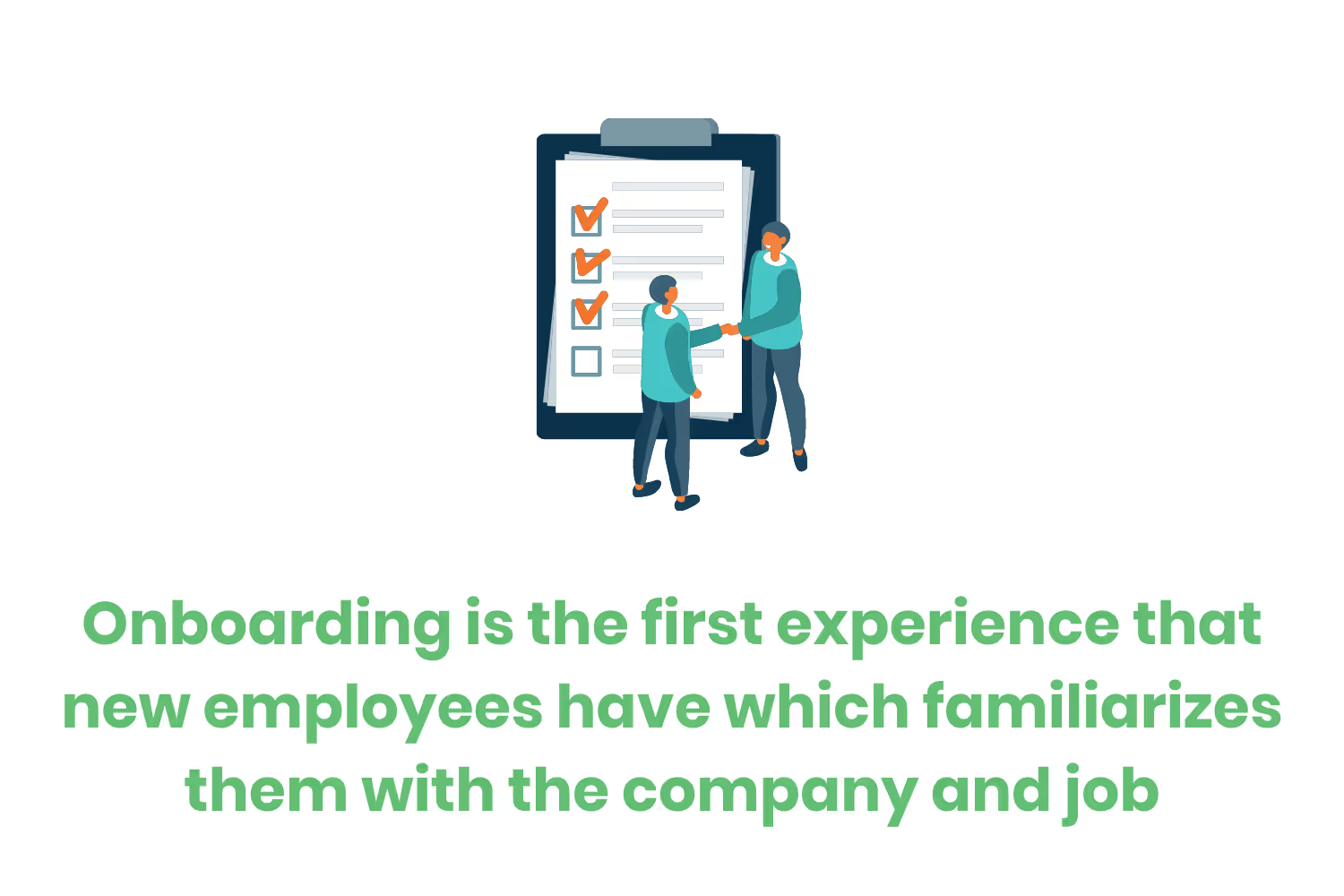
Maybe you don’t think that much needs to go into onboarding. Don’t they just need to sign some paperwork, know where their desk is, and be able to log in to their email account?
While it sounds ideal for it to be that simple of a process, onboarding involves more than that. You don’t want them to feel lost on their first day and be nervous to ask questions because you didn’t give them much direction initially.
If your onboarding process isn’t thorough enough, then they’re going to feel like you threw them into the deep end. And that’s a recipe for making them even more nervous. They don’t want to make a mistake because you didn’t give them all of the information they needed from the start. But they also don’t want to look foolish by asking too many questions.
To avoid making them even more anxious on their first day (and first weeks), your administration needs a cohesive onboarding plan.
So what do you need to go over with new hires when they start at your company? Here’s an onboarding checklist we made so that the process is easier for you.
Paperwork
Arguably the most exciting part of onboarding is completing all the required paperwork. This is what makes it possible for the employee to officially work for the company.
Of course, I’m being facetious. No one enjoys filling out what seems like an endless amount of pages with personal information. Most of them get repetitive and it becomes monotonous.
Nevertheless, they’re necessary. Each of these forms also falls into different categories.
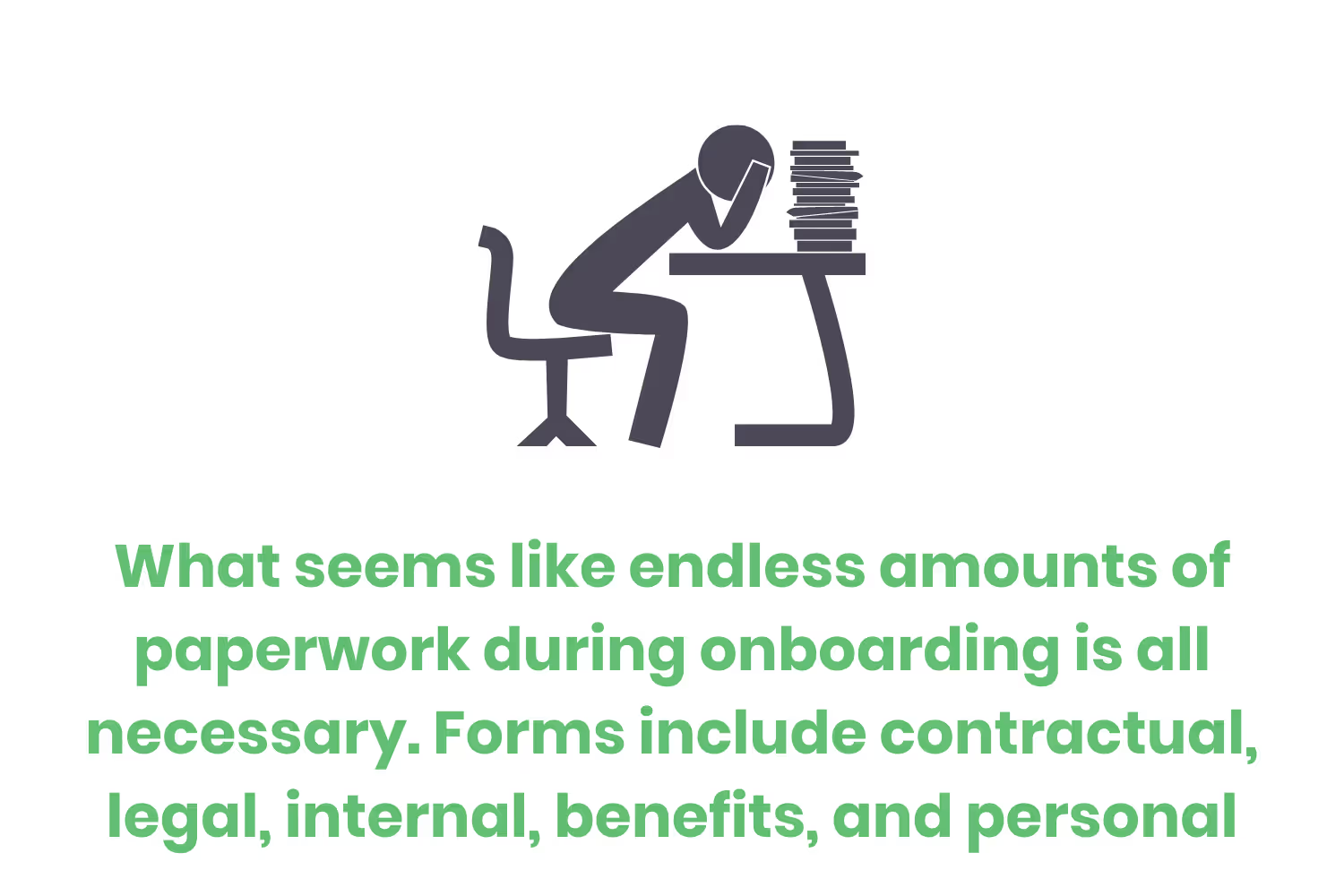
Contractual
These acknowledge the basic elements of the job position that the employee is accepting…
- Job title, department, and responsibilities
- Work schedule
- Length of employment (if applicable)
- Compensation and benefits
- Termination conditions
Legal
These forms ensure that the employee can legally work for the company and get paid.
- W-4 form (or W-9 for contractors)
- I-9 Employment Eligibility Verification form
- State Tax Withholding form
- Direct Deposit form
- E-Verify system (verifies employee eligibility in the US)
Internal
This includes any additional requirements of your company, such as…
- Employee handbook acknowledgment forms
- Drug and/or alcohol testing agreements
- Background check consent agreement
Benefits Data
These acknowledge all of the benefits that the employee has, in addition to their regular compensation. By providing this during onboarding, they’ll know all the perks that they can take advantage of, such as…
- Retirement plan
- Life and health insurance
- Disability insurance
- Sick time
- Paid time off
- Holidays
Personal
These may go under the radar, but they’re also still important. These indicate any personal information that the company may need in the event of an emergency.
- Emergency contact information
- Food allergies
So as you can see, there’s a lot of paperwork involved in onboarding. It doesn’t sound exciting, but it’s the necessary first step in getting your employee started. Although, you probably both already knew that. This seems to make up the majority of the first day on the job.
Sending these documents before the first day gives more time to complete them. That way they can have more time for other onboarding tasks when they arrive if they've already finished these papers.
Or since not everyone has access to a printer to do it before the first day, they’ll at least know in advance what they'll need to fill out so they can breeze right through it. It’s important to provide them with a copy of their completed documents if they do fill them out at the office. That way, they also have a record of what they signed.
Prepare Equipment
The next step to onboarding is preparing the equipment that the employee will use. If they’ll have a company device, you need to set it up so it’s ready for them to work. Add any protections onto the equipment so that data stays secure.
Likewise, if there are any accounts that new hires need access to, now is the time to set up those as well. For instance, they’ll likely need a company email address at the very least.
If you already have these created, then they can change their password as soon as possible when they arrive. That way, they secure their account with their unique login credentials instead of the automated password.
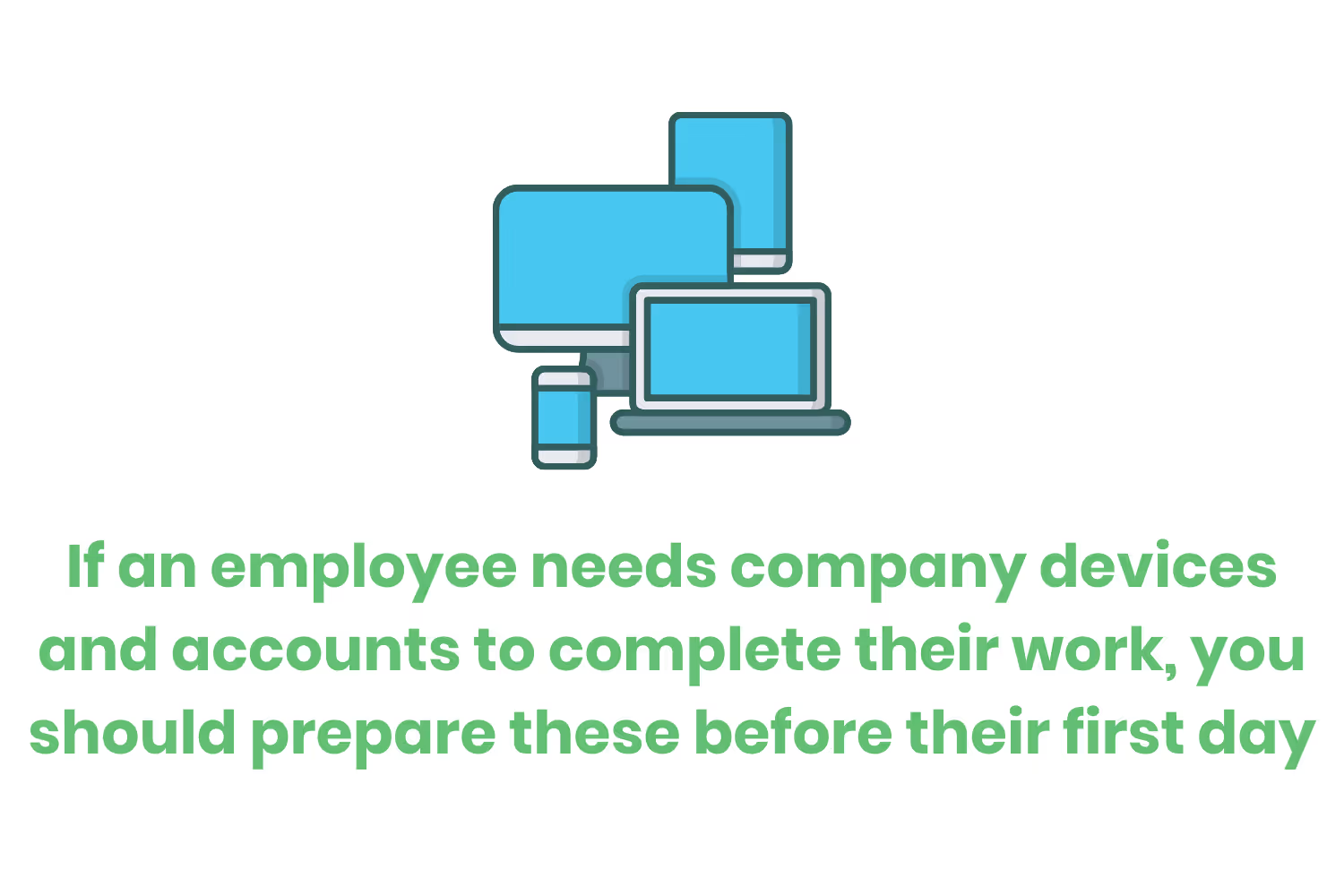
For those who work remotely, you need to make sure you send any devices ahead of time so that they have these for their first day. You’d hate for them to not even be able to do their job because you didn’t send the equipment that they’d rely on to get their work done.
Introductions
An important part of work is teamwork and collaboration. This isn’t possible for someone new if they don’t know anyone.
That’s why it’s important to make introductions part of your onboarding process. First, they should receive a welcome email from each of the key team members with whom they’ll be collaborating regularly. That way, they know who to approach about certain tasks.
Then, you need to send an email to your current staff announcing the new team member. It’s easier for all of them to remember one individual’s name than this person to remember everyone else’s at once. That will make it easier for people to introduce themselves as they see this new face.
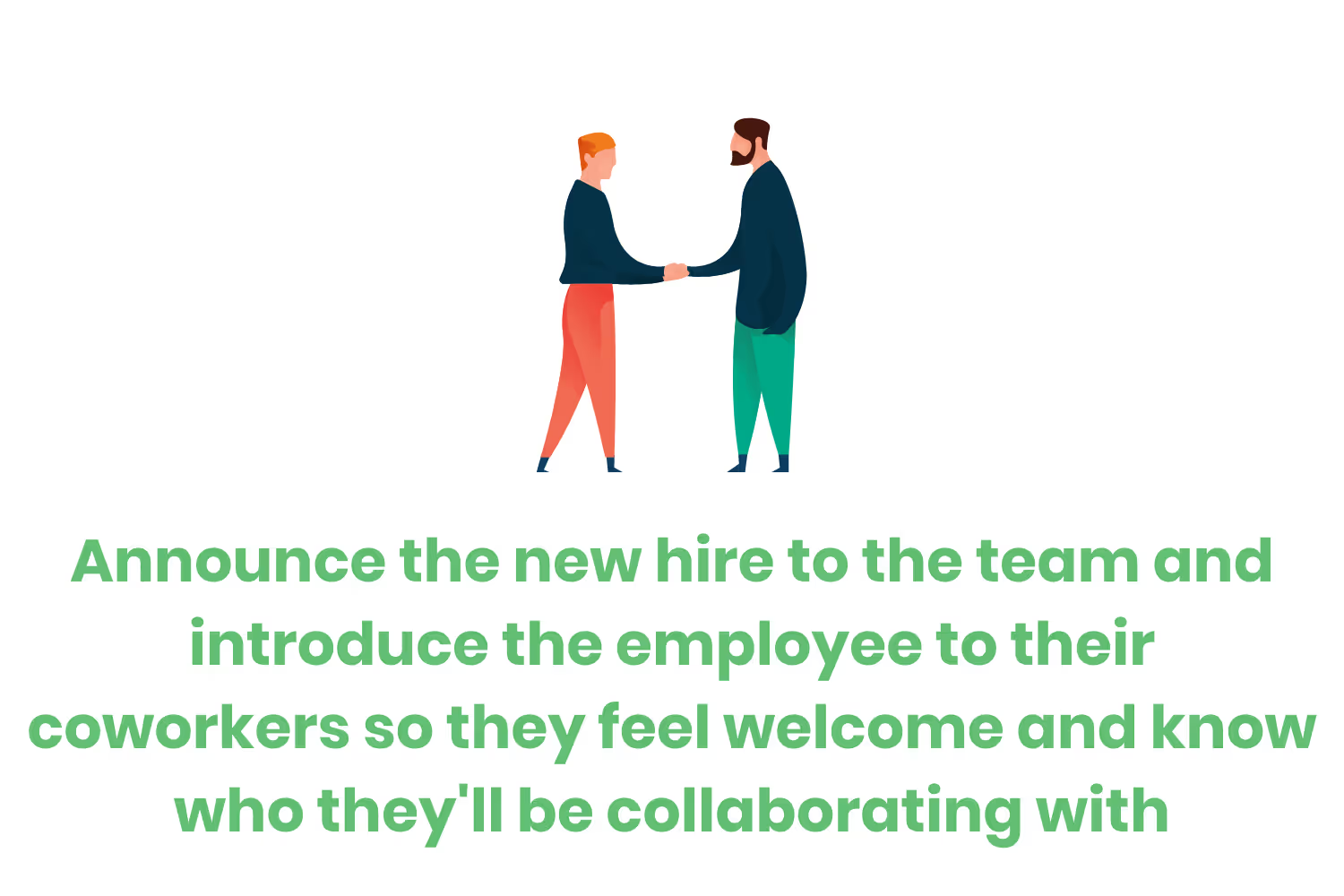
Once they do arrive in person, someone should take them around the office to meet everyone in person so they can at least familiarize themselves with their coworkers and where to find them. This will also help them get to know the office building itself and how to find their way around.
It’s also helpful to give them a list of important contacts in the office. For instance, who should they email if they have an issue connecting to the network? Or who do they approach with questions about benefits and payroll?
If they have these contact names, there’s less pressure to remember everyone’s name and role when they initially meet them on their first day.
Company Policies
New staff won’t know how to adhere to company policies and rules if you don’t communicate these to them. You want to do this when they first start so that they’re set up for consistency and success.
This goes hand-in-hand with internal paperwork. Provide any policies in written documents so they have them for their reference. If they have any questions or concerns, they can refer back to these for more details.
Just some of the information you should include are policies regarding…
- Benefits
- Pay period schedule
- Cybersecurity safeguards
- Paid time off
- Device usage
- Insurance plans
- Break time
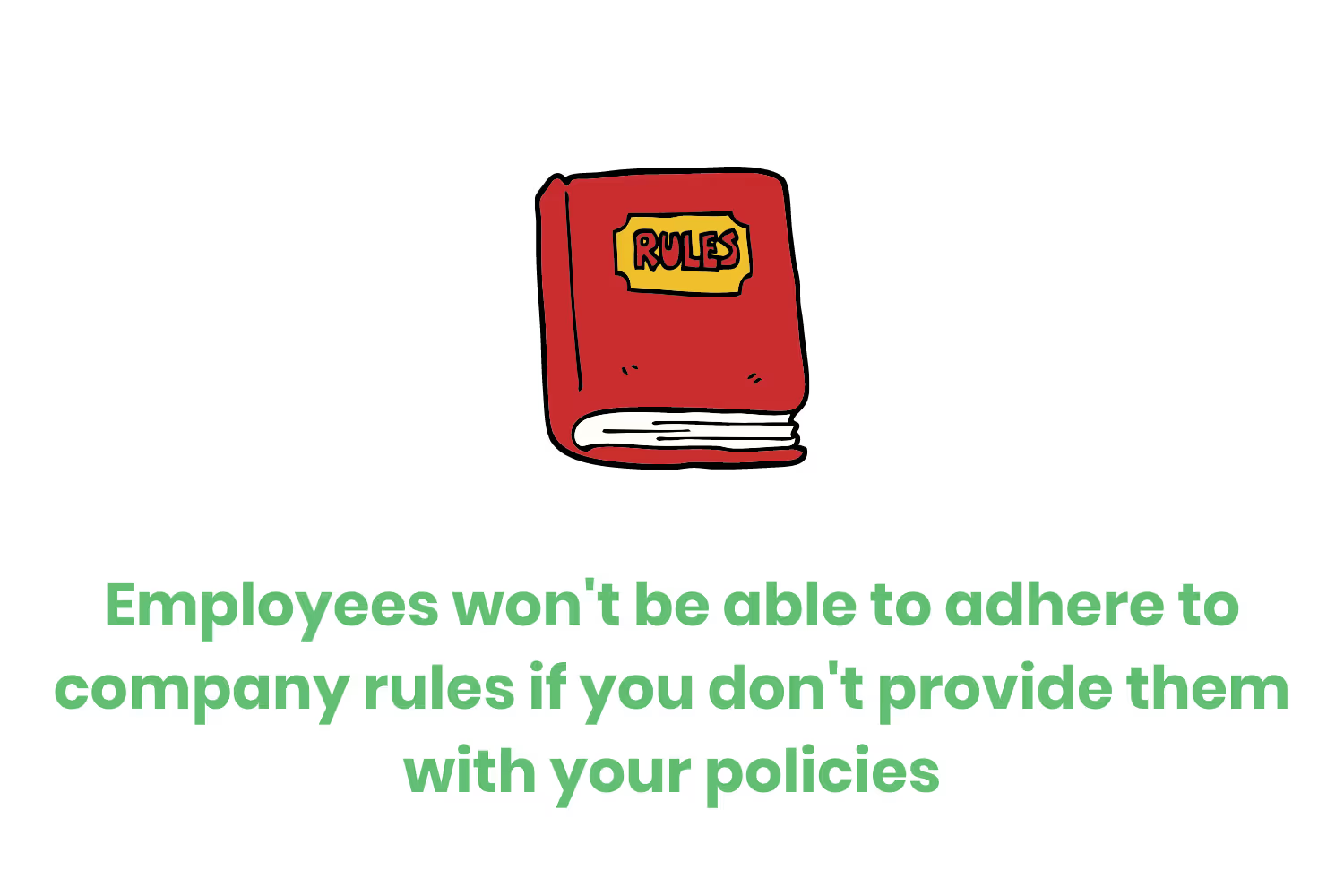
Set Expectations and Goals
When anyone starts at a job, they might be wondering what all responsibilities they’re going to have each day. Of course, they know overall what the job entails since they saw the job description in their application and then discussed it in their interview.
But every day can look different, and other tasks come up all the time. To help your new staff be successful, you should go over their responsibilities during onboarding. Now, you don’t need to overwhelm them with explaining every single item that they need to do. Onboarding doesn’t all have to happen on the first day.
First, you can go over the key expectations. Then, gradually show them the tasks that they’ll need to take on as they become more familiar with processes and how to complete them.
Also set expectations for what their work schedule is. Is there a certain amount of time that they should be spending on a given task? Do they have a flexible schedule, or should they be working within specific hours every day?
It’s even helpful to set goals so that they have something to work towards right away. This establishes a more clear direction for what they should focus on initially. They can then revisit these goals, whether short-term or long-term, with their supervisor to assess how they’re adjusting.
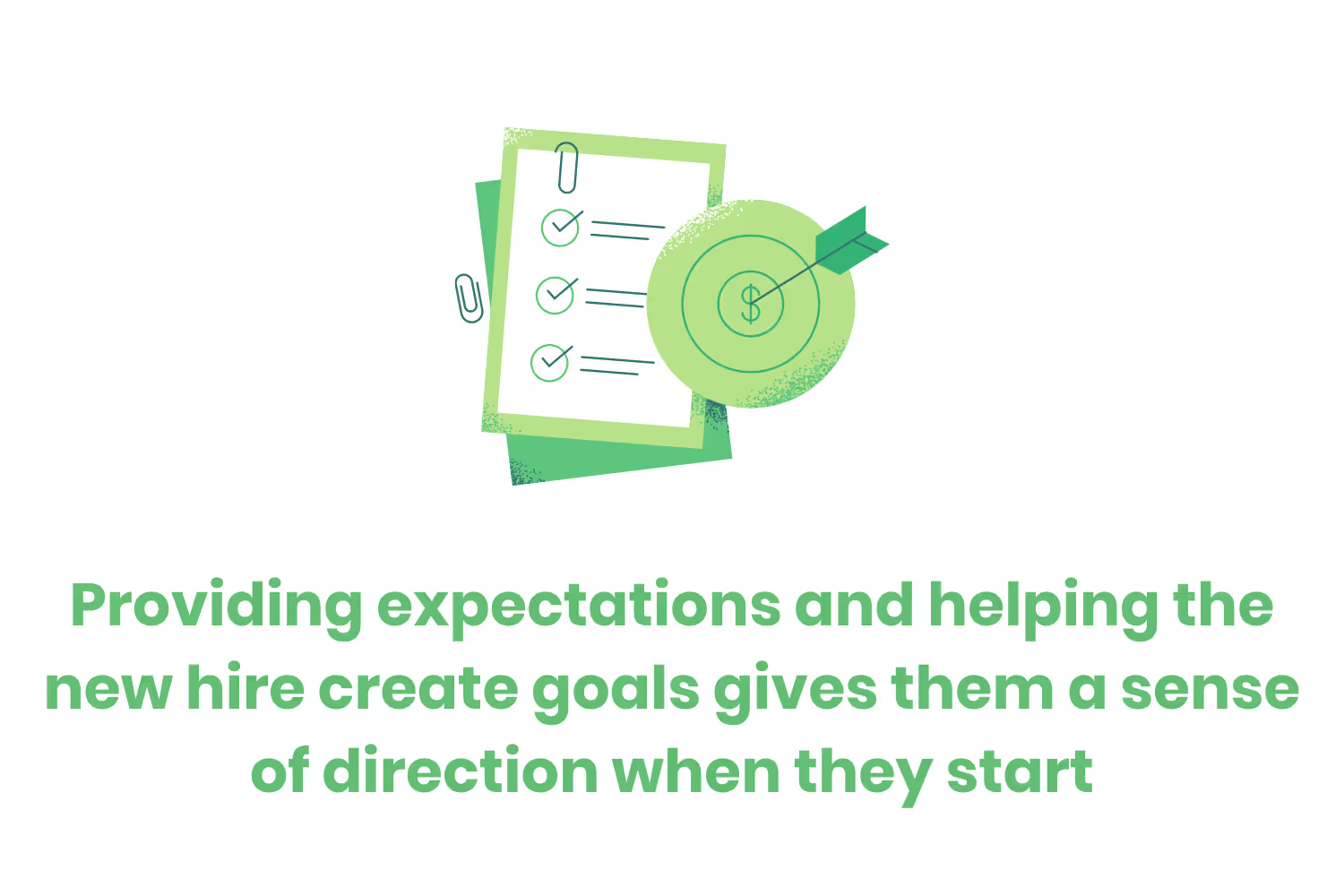
Be sure to define these evaluation and progress report timelines. You wouldn’t want to surprise the new hire with an evaluation only a few weeks after they start with no warning. This could make them anxious that they didn’t give a good impression if they already need an evaluation.
But if they know to expect these progress reports, they'll have the motivation to get acquainted with the company and its processes.
Provide Helpful Resources
No matter how perfect your onboarding process is, there’s still room for workplace stress and anxieties. After all, it’s a lot of information to be giving your new team member. Because it’s overwhelming to remember everything in the first few days, provide them with documents that include the key details to know.
That will relieve some of the anxiety about remembering it all or writing it all down.

Burnout and imposter syndrome are two negative workplace feelings that can occur for people, no matter how much someone enjoys their job. So offering resources for how to manage and alleviate these problems is beneficial if they ever do start to experience them.
This isn’t to make them intimidated that they’re going to face workplace stressors. If you give resources for preventing and managing them, then they won’t be inevitable.
Collect Feedback
Finally, collect feedback from your new employees regarding the onboarding process. There’s no better way to improve the experience for future staff than by asking for suggestions from those who went through onboarding.
Complete this phase with a survey so you can collect their thoughts on what you can improve on. That way, you can continue to make this experience seamless and enjoyable for everyone that starts working for your company.
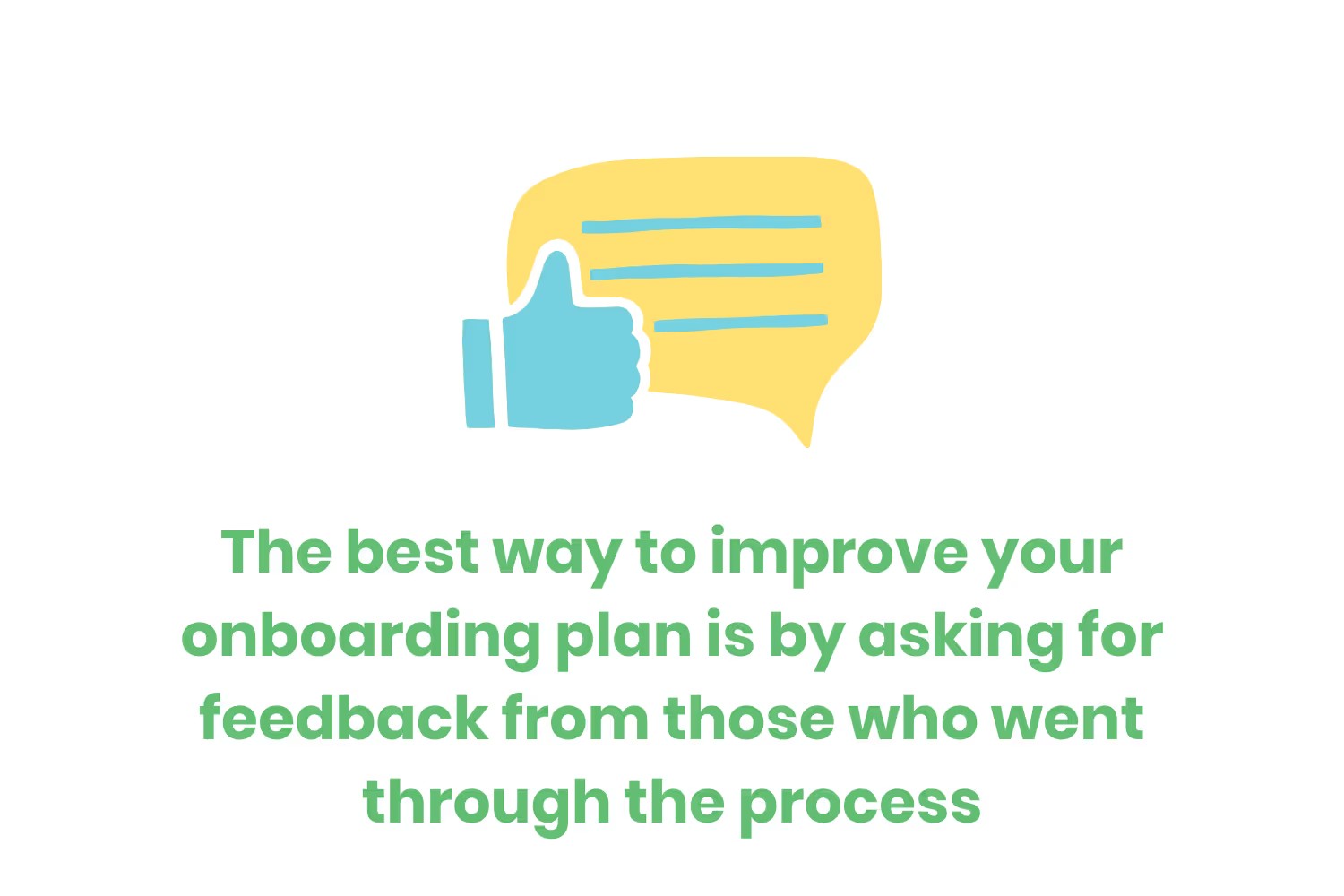
Conclusion
When someone new starts at your company, you want to show them that they made the right choice by joining the team. They aren’t the only ones who need to make a good first impression.
The first stage of their experience with the organization is onboarding, which sets the tone for their new position. Likely, they’ll already be nervous to start, so you don’t want this process to make that worse or give them doubts about working for you.
Each of these steps is key to a thorough onboarding plan so that staff has the information they need but don’t feel stressed by how much they have to remember. They’ll feel prepared to start their new career and have the resources that they need to be successful.
Emphasize your product's unique features or benefits to differentiate it from competitors
In nec dictum adipiscing pharetra enim etiam scelerisque dolor purus ipsum egestas cursus vulputate arcu egestas ut eu sed mollis consectetur mattis pharetra curabitur et maecenas in mattis fames consectetur ipsum quis risus mauris aliquam ornare nisl purus at ipsum nulla accumsan consectetur vestibulum suspendisse aliquam condimentum scelerisque lacinia pellentesque vestibulum condimentum turpis ligula pharetra dictum sapien facilisis sapien at sagittis et cursus congue.
- Pharetra curabitur et maecenas in mattis fames consectetur ipsum quis risus.
- Justo urna nisi auctor consequat consectetur dolor lectus blandit.
- Eget egestas volutpat lacinia vestibulum vitae mattis hendrerit.
- Ornare elit odio tellus orci bibendum dictum id sem congue enim amet diam.
Incorporate statistics or specific numbers to highlight the effectiveness or popularity of your offering
Convallis pellentesque ullamcorper sapien sed tristique fermentum proin amet quam tincidunt feugiat vitae neque quisque odio ut pellentesque ac mauris eget lectus. Pretium arcu turpis lacus sapien sit at eu sapien duis magna nunc nibh nam non ut nibh ultrices ultrices elementum egestas enim nisl sed cursus pellentesque sit dignissim enim euismod sit et convallis sed pelis viverra quam at nisl sit pharetra enim nisl nec vestibulum posuere in volutpat sed blandit neque risus.

Use time-sensitive language to encourage immediate action, such as "Limited Time Offer
Feugiat vitae neque quisque odio ut pellentesque ac mauris eget lectus. Pretium arcu turpis lacus sapien sit at eu sapien duis magna nunc nibh nam non ut nibh ultrices ultrices elementum egestas enim nisl sed cursus pellentesque sit dignissim enim euismod sit et convallis sed pelis viverra quam at nisl sit pharetra enim nisl nec vestibulum posuere in volutpat sed blandit neque risus.
- Pharetra curabitur et maecenas in mattis fames consectetur ipsum quis risus.
- Justo urna nisi auctor consequat consectetur dolor lectus blandit.
- Eget egestas volutpat lacinia vestibulum vitae mattis hendrerit.
- Ornare elit odio tellus orci bibendum dictum id sem congue enim amet diam.
Address customer pain points directly by showing how your product solves their problems
Feugiat vitae neque quisque odio ut pellentesque ac mauris eget lectus. Pretium arcu turpis lacus sapien sit at eu sapien duis magna nunc nibh nam non ut nibh ultrices ultrices elementum egestas enim nisl sed cursus pellentesque sit dignissim enim euismod sit et convallis sed pelis viverra quam at nisl sit pharetra enim nisl nec vestibulum posuere in volutpat sed blandit neque risus.
Vel etiam vel amet aenean eget in habitasse nunc duis tellus sem turpis risus aliquam ac volutpat tellus eu faucibus ullamcorper.
Tailor titles to your ideal customer segment using phrases like "Designed for Busy Professionals
Sed pretium id nibh id sit felis vitae volutpat volutpat adipiscing at sodales neque lectus mi phasellus commodo at elit suspendisse ornare faucibus lectus purus viverra in nec aliquet commodo et sed sed nisi tempor mi pellentesque arcu viverra pretium duis enim vulputate dignissim etiam ultrices vitae neque urna proin nibh diam turpis augue lacus.




